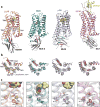Nanobodies to Study G Protein-Coupled Receptor Structure and Function
- PMID: 27959623
- PMCID: PMC5500200
- DOI: 10.1146/annurev-pharmtox-010716-104710
Nanobodies to Study G Protein-Coupled Receptor Structure and Function
Abstract
Ligand-induced activation of G protein-coupled receptors (GPCRs) is a key mechanism permitting communication between cells and organs. Enormous progress has recently elucidated the structural and dynamic features of GPCR transmembrane signaling. Nanobodies, the recombinant antigen-binding fragments of camelid heavy-chain-only antibodies, have emerged as important research tools to lock GPCRs in particular conformational states. Active-state stabilizing nanobodies have elucidated several agonist-bound structures of hormone-activated GPCRs and have provided insight into the dynamic character of receptors. Nanobodies have also been used to stabilize transient GPCR transmembrane signaling complexes, yielding the first structural insights into GPCR signal transduction across the cellular membrane. Beyond their in vitro uses, nanobodies have served as conformational biosensors in living systems and have provided novel ways to modulate GPCR function. Here, we highlight several examples of how nanobodies have enabled the study of GPCR function and give insights into potential future uses of these important tools.
Keywords: G protein–coupled receptor; conformational plasticity; crystallographic chaperone; intrabody; nanobody; receptor activation.
Figures





References
-
- Lagerström MC, Schioth HB. Structural diversity of G protein-coupled receptors and significance for drug discovery. Nat Rev Drug Discov. 2008;7:339–57. - PubMed
-
- Lefkowitz RJ. Historical review: a brief history and personal retrospective of seven-transmembrane receptors. Trends Pharmacol Sci. 2004;25:413–22. - PubMed
-
- Palczewski K, Kumasaka T, Hori T, Behnke CA, Motoshima H, et al. Crystal structure of rhodopsin: a G protein-coupled receptor. Science. 2000;289:739–45. - PubMed
-
- Pierce KL, Premont RT, Lefkowitz RJ. Seven-transmembrane receptors. Nat Rev Mol Cell Biol. 2002;3:639–50. - PubMed
Publication types
MeSH terms
Substances
Grants and funding
LinkOut - more resources
Full Text Sources
Other Literature Sources

